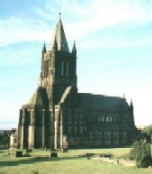|
|
FUGUE:
CHAPTER V111
THE
ORGAN APPEAL OF 1974, THE FIRST STAGE OF THE RESTORATION
AND
THE CENTENARY OF THE ORGAN AT ARMLEY
-
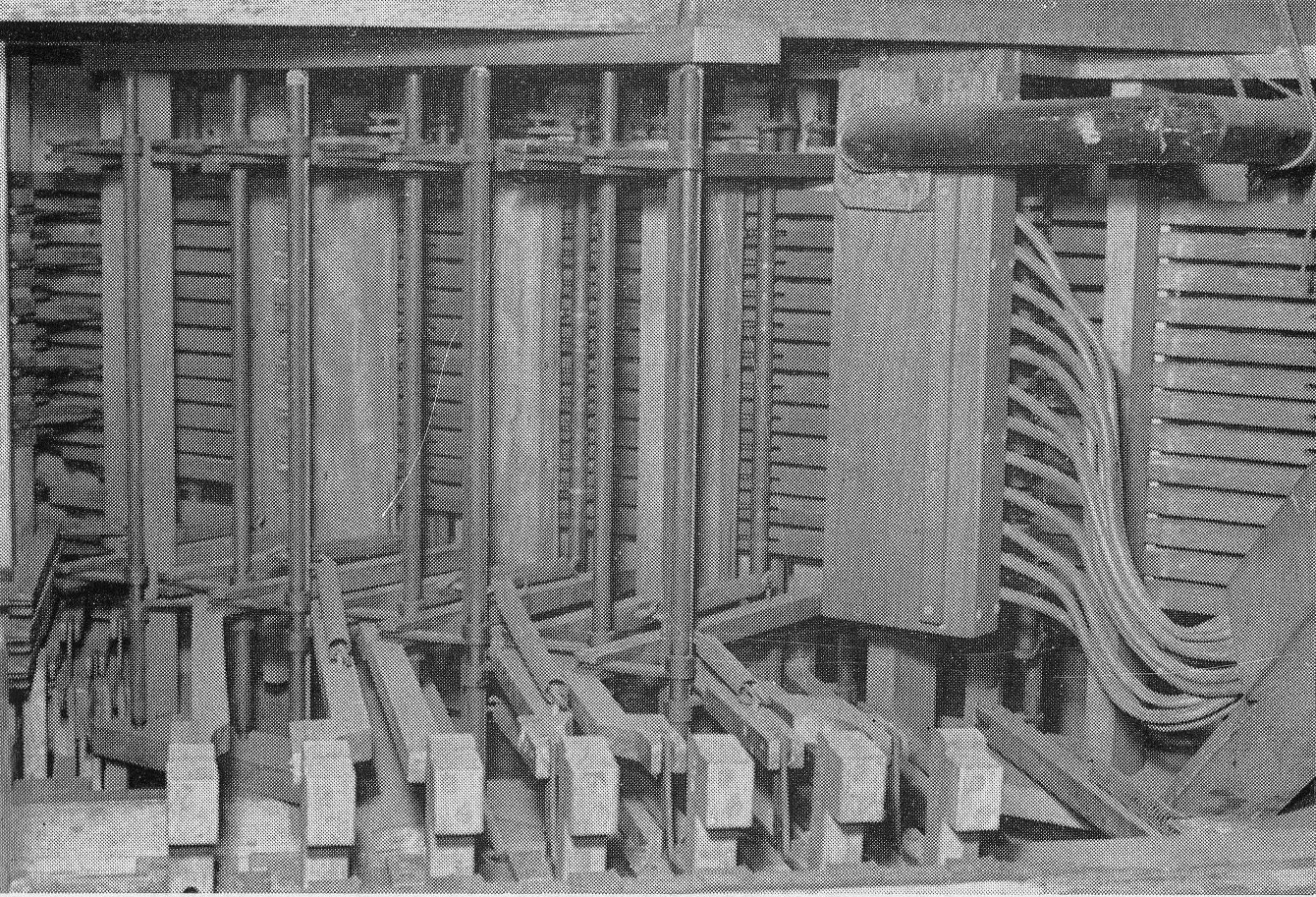 Mechanism
of the Binns adjustable pneumatic system operating
Mechanism
of the Binns adjustable pneumatic system operating
the
stop knobs on the left of the console. Removed in 1976.
|
|
The
renovation of 1956 retained the tubular-pneumatic actions to
keys, pedals, couplers and stops inserted by J. J. Binns in
1905. By 1973 it became apparent that this mechanism was
deteriorating rapidly. The key actions were sluggish, the
adjustable piston mechanism had become quite unreliable and
the pistons and combination pedals were very noisy when
operated – all this despite the careful maintenance of
the instrument by Mr. J. T. Jackson. Further, examination of
the pneumatic actions showed that corrosion of the steel wires
had reached such a stage that within a very few years,
probably before the centenary of the installation of the organ
at Armley, notes would become silent and the instrument would
no longer be fit for recital purposes and would become an
increasing liability to the church. This situation was
aggravated by the extreme inaccessibility of the manual
pneumatic action and the manual to pedal couplers immediately
behind the console, due to the bulky adjustable piston action.
|
The
financial position was serious because not only could the parish
no longer rely on the former wealthy members of the congregation
to assist, but inflation had caused an unprecedented rise in the
cost of organ-building. Therefore in October, 1974, under the
chairmanship of Mr. Arnold Mahon the organist, after consideration
of tenders from several eminent firms, an appeal was launched to
raise the large sum of £25,000 for a complete reconstruction
of the action, overhaul of the soundboards, wind trunks and
reservoirs, and modernisation of the Binns console to
international standards, with new keyboards and pedal-board.
The
Appeal was inaugurated with a Celebrity Concert in the church on
20th October, 1974, at which Haydn's "Creation" (parts
one and two) was sung magnificently by a section of the
Huddersfield Choral Society, under the conductorship of Douglas
Robinson, Mus.B., F.R.C.O., a former chorister of St.
Bartholomew's and a lover of its organ. The soloists Anne Pashley,
soprano, Richard Greager, tenor and Robert Lloyd, bass, all from
the Royal Opera House, Covent Garden, gave of their best in a
memorable performance, ably supported by the Sinfonia of Leeds
orchestra and attended by a large audience. A reception
followed, attended by the Lord Mayor of Leeds, at which Dr.
Francis Jackson of York Minster spoke on the importance and unique
tonal qualities of the organ, followed by Mr. Ernest Bradbury, the
music critic. Many messages of goodwill were received, including
one from Elsie Suddaby, the Armley-born soprano.
Mr.
Ralph Downes, organist of Brompton Oratory, was appointed
as consultant to advise on the best type of action to retain the
characteristic Schulze tone. After a thorough examination of the
instrument in collaboration with Mr. Arnold Mahon, including tests
on Schulze pipes carried out at Brompton Oratory and at The Royal
Festival Hall, Mr. Downes advised the Organ Committee that the
type of action operating the soundboard pallets had a great effect
on the speech of the pipes. Originally voiced on soundboards with
mechanical (tracker) action for Choir and Echo Organs, and
Barker-lever action for Great and Swell Organs, the
tubular-pneumatic actions in their worn-out state operate the
pallets too rapidly and impair the speech of the pipes, especially
of the Principal stops, to a distressing degree. In Mr. Downes'
opinion, this serious defect may have been present to a less
extent when the tubular-pneumatic actions were installed in 1905,
but fortunately J. J. Binns made no attempt to correct it by
re-voicing the pipes, as occurred at St. Peter's Church, Hindley,
Lancashire, in 1907, when the Schulze tone was lost as regards the
Diapason chorus.
Many
suggestions were received for replacement of the action, from the
several firms approached and from individuals:
Ralph Downes,
1904-1994
|
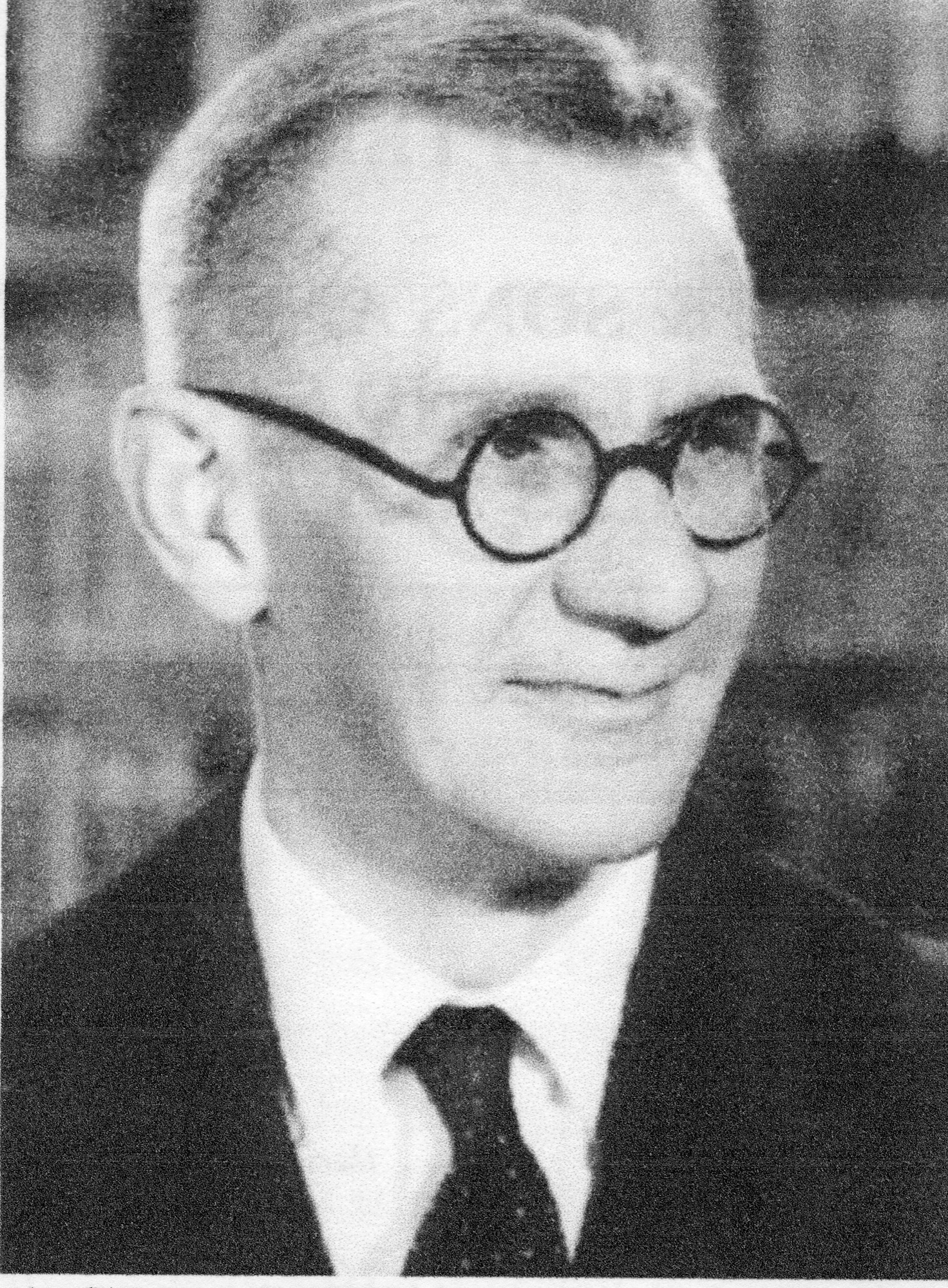
|
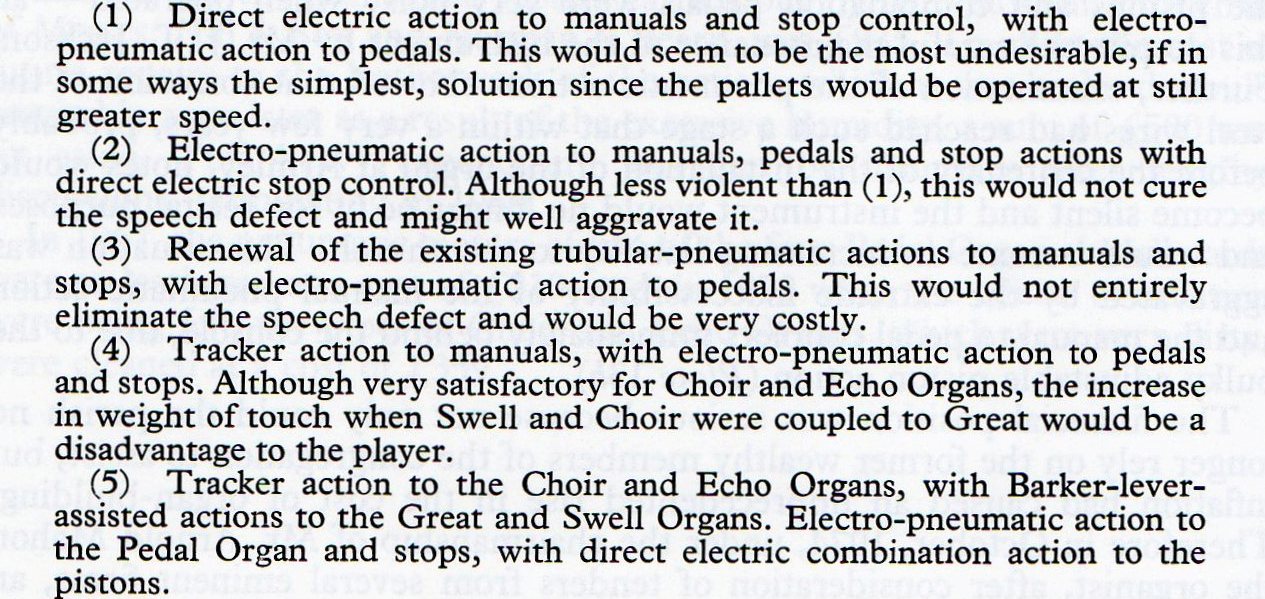
|
The
last proposal was put forward after much thought by Mr.
Ralph Downes, but no decision was
taken by the authorities at
St. Bartholomew's because, as
explained later, insufficient funds were available for any major
scheme to be considered. Mr. Downes subsequently had second
thoughts about the Pedal Organ action and at present advises the
retention of tubular-pneumatic action for that department of the
organ.
Of
the suggestions for replacement of the action, the last is the
only one which, for the manual departments, would return the
instrument to the condition in which Schulze left it, as closely
as possible, whilst the Pedal Organ would benefit from the
application of electro-pneumatic action. Control of the stops by
correctly placed pistons operating the stop knobs by solenoids and
adjustable at a switchboard, would greatly facilitate changes in
registration. The octave and suboctave couplers added by Binns
would all disappear and could no longer be used to obtain effects
which were never envisaged by Schulze and which often upset the
tonal balance, although much used by some players in the past. The
essential intermanual and manual to Pedal couplers would be
retained, including the valuable Echo to Pedal coupler added by
Binns, together with the Tremulants to Choir, Swell and Echo
Organs.
Unfortunately,
the response to the Appeal, largely due to the unfavourable
economic climate, was quite inadequate to allow the major
restoration scheme to go forward, and the return to tracker and
Barker lever actions has had to be postponed until the necessary
financial support is forthcoming. With the money raised by the
many individual subscriptions from lovers of the organ, together
with generous donations from the Pilgrim Trust and the West
Yorkshire Metropolitan County Council, a start has been made by
the removal of the cumbersome Binns adjustable combination action
to stops and pistons, and by its replacement with a compact direct
electric system. The handsome Binns stop jambs have been retained,
after re-arrangement of the ivory stop knobs in accordance with
modern practice. The Pedal stops have therefore been transferred
to the left-hand jamb in exchange for the Choir stops, which are
now on the right-hand jamb, whilst the Great stops have been moved
to the extreme right position. All speaking stops are now arranged
in the order shown on the original stop jambs, preserved in the
organ gallery.
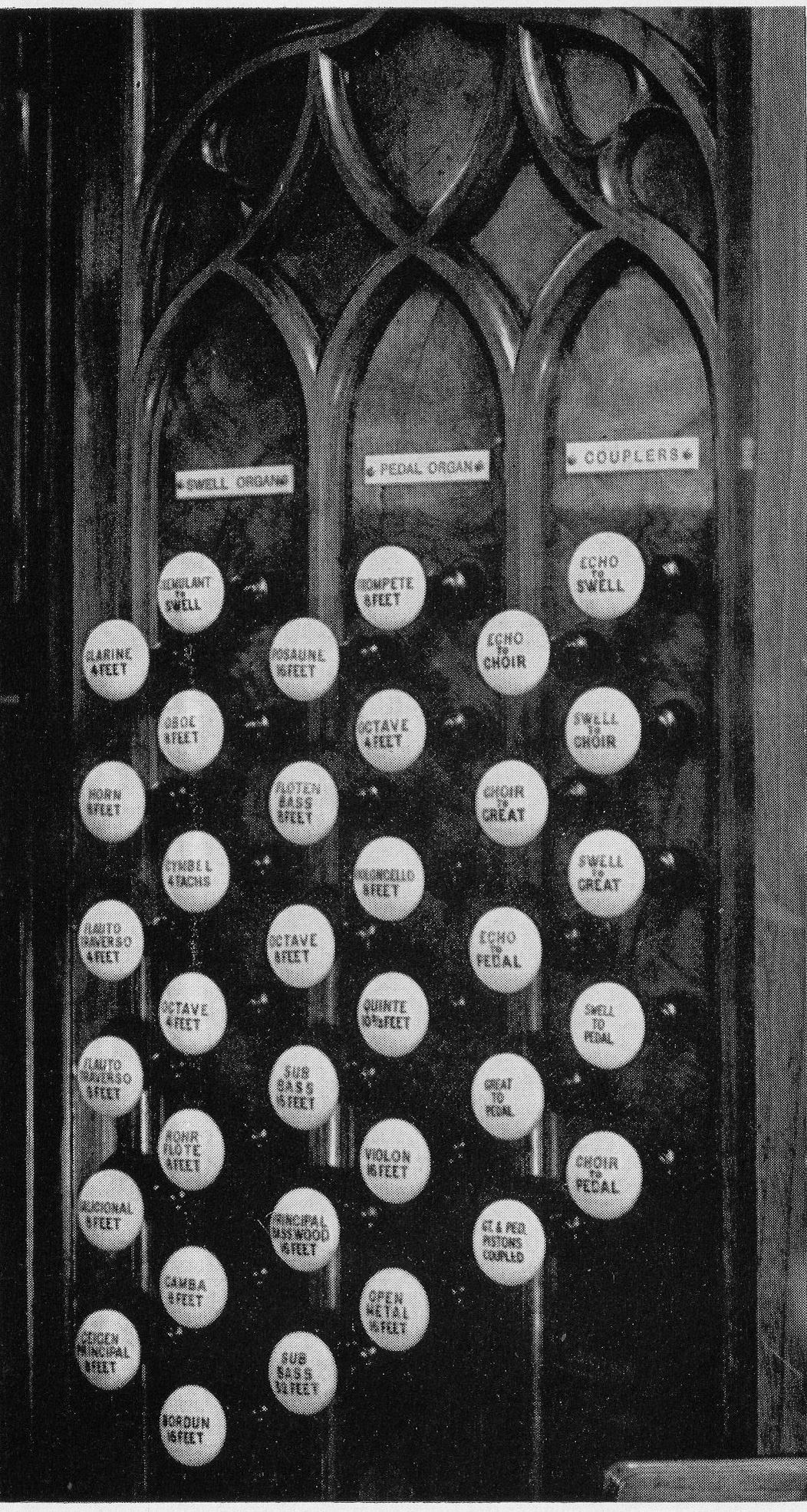
|
Left:
1976 - Left hand stop jamb, after removal of
octave and
suboctave couplers and transfer of
Pedal stops to this
jamb.
Right:
1976 – Right hand stop jamb after transfer of
Choir
stops to this jamb.
With
the money raised by the many individual subscriptions from
lovers of the organ, together with generous donations from the
Pilgrim Trust and the West Yorkshire Metropolitan County
Council, a start has been made by the removal of the cumbersome
Binns adjustable combination action to stops and pistons, and
by its replacement with a compact direct electric system. The
handsome Binns stop jambs have been retained, after
re-arrangement of the ivory stop knobs in accordance with
modern practice. The Pedal stops have therefore been
transferred to the left-hand jamb in exchange for the Choir
stops, which are now on the right-hand jamb, whilst the Great
stops have been moved to the extreme right position. All
speaking stops are now arranged in the order shown on the
original stop jambs, preserved in the organ gallery.
|
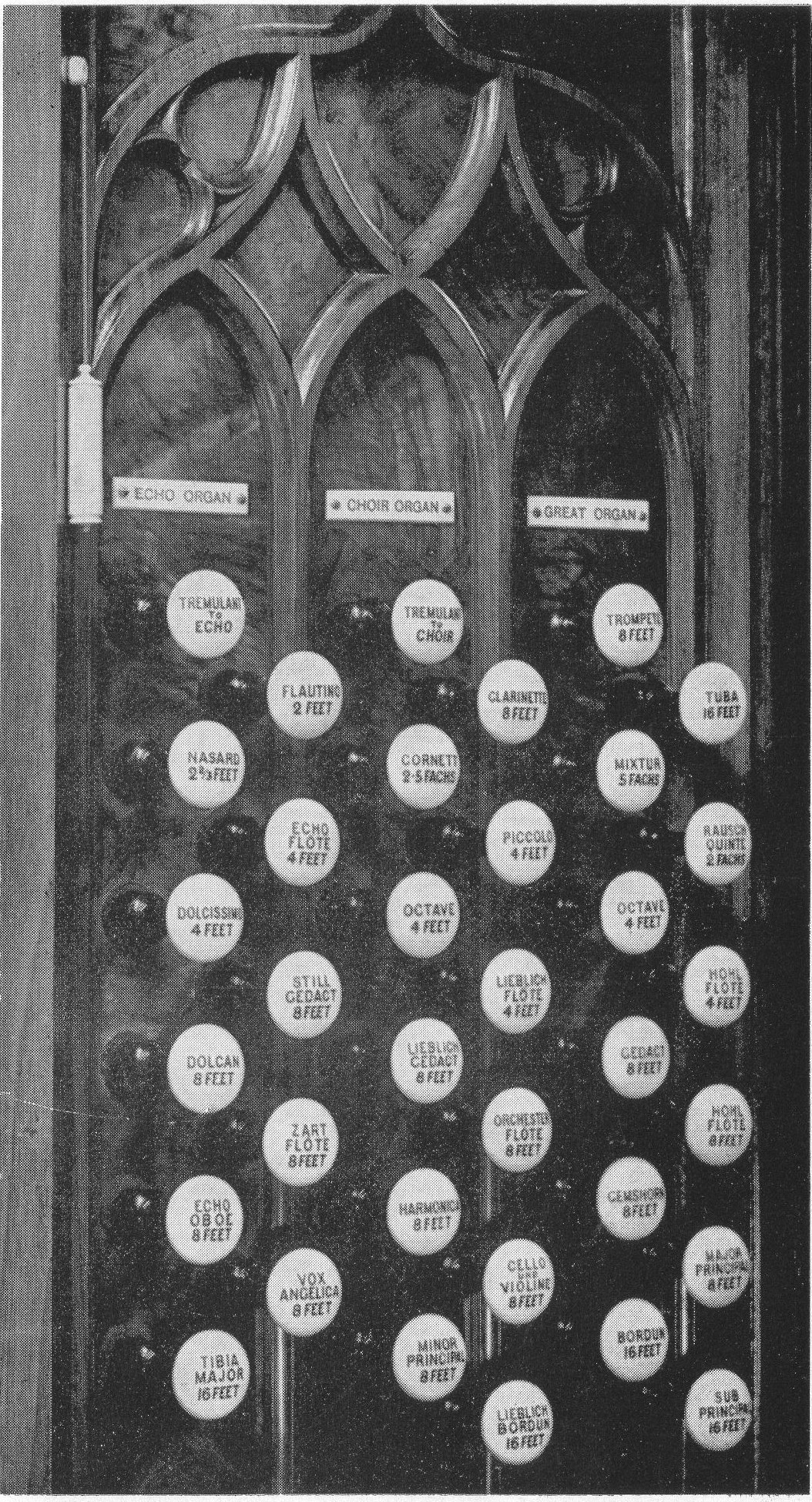
|
The
positions formerly occupied by the discarded octave and
suboctave couplers are now filled by five inter manual
couplers, four manual to pedal couplers and a stop knob
coupling the Great and Pedal combination pistons. Four thumb
pistons to the Choir Organ, six to the Great Organ, six
(duplicated by toe pistons) to the Swell Organ, four to the
Echo Organ and six toe pistons to the Pedal Organ, are
adjustable at a switchboard accessible from the organ gallery.
Reversible thumb pistons operate the Swell to Pedal, Great to
Pedal and Swell to Great couplers, the two latter being
duplicated by toe pistons, and a General Cancel piston to all
stops and couplers is provided. The stop actions have been
converted to electro- pneumatic operation, but the manual to
pedal couplers remain mechanical in action. The balanced swell
pedal, which was formerly too near to the player, has been
moved back to a normal position and the Piccolo stop of the
Choir Organ has been restored to its original 4ft. pitch as
provided by Schulze.
This
work, which forms part of the main restoration scheme, has been
carried out by John T. Jackson & Son of Leeds. It has made
control of the registration convenient for the player, prompt
in response, reliable and much more silent than formerly,
whilst the removal of the old combination mechanism gives
access to the rear of the large console for maintenance, which
was previously almost inaccessible. It is hoped that several
small stages on this scale can be carried out until a major
restoration can be undertaken.
|
|
 1976
– New Thumb pistons operating the stop knobs
by direct
electric action and adjustable at a switchboard
1976
– New Thumb pistons operating the stop knobs
by direct
electric action and adjustable at a switchboard
|
|
|
The
organ was re-opened on
17th May, 1976, by Ralph Downes in
a memorable recital designed to display the tonal beauties of
the organ, with this programme:
|

|
No
major funds had become available since the first publication of
this book in 1978 to enable the ideal restoration of the organ
advised by Ralph Downes, as consultant, to take place, which would
cost over £125,000 in 1985, at the time of writing. The
pneumatic actions of 1905 were becoming still more sluggish and at
differing rates, making co-ordinated playing increasing difficult,
whilst perishing of the leatherwork in the Echo Organ and in the
bass octave of the Swell Organ is now serious. Temporary repairs
have been made by J. T. Jackson & Son, but the small funds
available must be conserved as far as possible to meet emergencies
as they arise.
Since
the great increase in the cost of oil in the 1970's the old
oil-fired heating system in the church has been little used, but
for the induction and installation of the Rev. R. G. N. Plant as
Vicar of Armley on 22nd January, 1982, the heating system was
turned on after a heavy frost which had, unobserved, burst a
cast-iron radiator in the blowing chamber. As a result, the Discus
blower sucked in hot water spray and vapour which were blown
through the large double-rise main reservoir mounted above the
Discus and carried up into the organ. After several weeks, when
the leatherwork of the reservoir had dried out and split, a
serious loss of wind was detected, whilst still later certain
notes of the Swell Organ reed stops became silent, due to the
combination of condensed, water vapour with dust and dirt on the
surfaces of the brass tongues. The other reeds in the organ were
unaffected, being outside the swellbox.
After
consultation on the site between Ralph Downes, the organ builder
and the organist, all the tongues of the Swell Organ reed stops
were cleaned, burnished and re-set by J. T. Jackson & Son,
taking especial care to retain the original tones. They also
repaired numerous splits in the resonators of these three stops
and restored the damaged main reservoir as a single-rise
unit, as described in a letter from Schulze to Kennedy. The cost
of this work was covered by insurance.
|
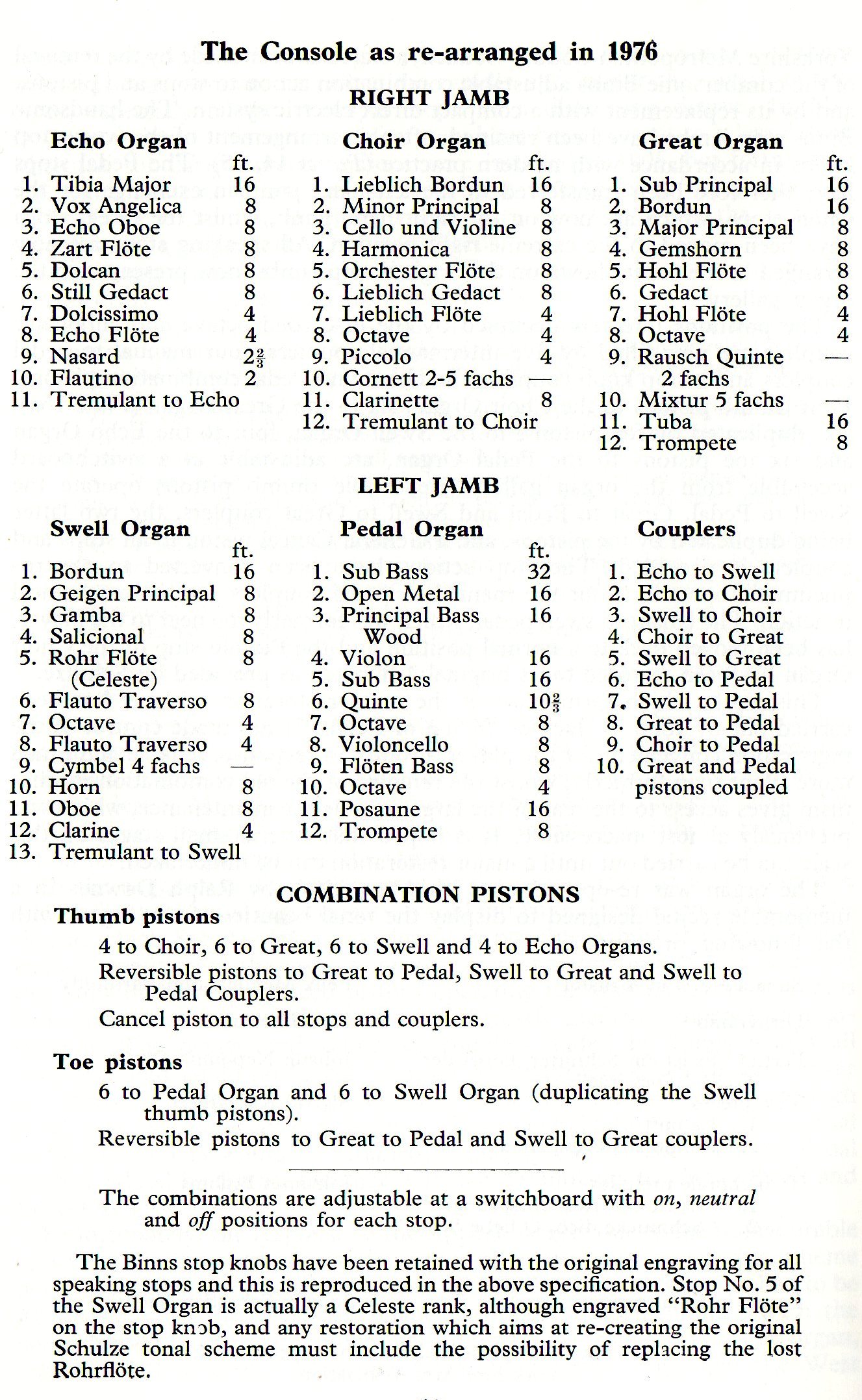
|
|
|
The
Centenary of the Installation of the Schulze Organ at Armley
|
|
In
1979 the Centenary of the coming of the Schulze Organ to St.
Bartholomew's Church was celebrated in Festival style, with a full
programme of events from May to September, arranged through the
enthusiasm and devotion of the present organist Arnold Mahon.
Included were recitals by Jennifer Bate (recorded by the B.B.C.),
Francis Jackson and the American organist Carlo Curley, all of
whom attracted large audiences: the last-named drew one of about
700. Francis Jackson's virtuoso playing included the premiere of
his Sonata No. 3, commissioned for the occasion with funds
provided by the Arts Council of Great Britain and dedicated to
Elsie Suddaby of happy memory (see Chapter VIII) whose second
cousin was Francis Jackson's mother.
During
the interval in Jennifer Bate's outstanding recital, Ralph Downes
gave a short talk: ‘The Schulze
Organ At Armley – an Appreciation of its Qualities and a
hope for its future’ which he
had originally given on BBC Radio 3 before a recital at St
Bartholomew's by Nicholas Kynaston:
“If
it could be said that 17th and 18th century organ-building in
England was shaken out of conservatism, revitalised and eventully
dominated by the influx of European traditions through the agency
of "Father" Smith, Renatus Harris, Iohn Snetzler and
others, until a new conservatism was reached and bogged it down
again; then one could argue that an equally radical process set in
during the second half of the 19th century, stemming from the
person and work of the German Edmund Schulze, who was born in
1824.
Schulze,
one of six grandsons in a distinguished organ-building family firm
which flourished in Paulinzelle in the mid-19th century, came to
London at the instigation of Prince Consort Albert to place a
small organ in the Great Exhibition of 1851. By the side of other
exhibits, (notably the monster organ built by Henry Willis) the
Schulze organ was extremely modest, but it appealed strongly to
the imagination of all who saw and heard it. They admired its
sturdy, wholesome construction and the excellence of the materials
employed, but especially the great volume of sound produced by the
"flue-chorus" of such a small instrument, voiced on very
moderate wind pressure, while English pressures were
escalating
like an inflationary spiral! These superior
qualities led immediately to his being given a number of organ
building commissions in England.
Edmund
Schulze, the eldest son and partner with his father, and chief
voicer, came with the organ and stayed for the period of the
Exhibition, When he returned with a Gold Medal - and minus the
organ - he could have had little idea of what was in store, for he
was a quiet modest man.
The
first commission was from Jeremiah Rogers, for a monster 4 (later
5) manual organ to replace his splendid 18th century instrument
which had burned down with St. George's Parish Church in Doncaster
in 1853: and many others, large and small, were to follow.
While
Schulze clearly adapted his style to meet English tastes and
requirements, these organs had a marked stylistic influence
on English organ building over the succeeding years, and
particularly on the work of one of our finest builders, T C Lewis.
But during the first half of the present century nearly all of
these manifestations have perished or been drastically modified
according to "modern" ideas. It was a sterile period of
organ building and it is true to say that the Armley organ is
unique in that it is the only large Schulze-style instrument in
Britain to have almost completely escaped the hand of the
rebuilder. The pipework, apart from the loss of one stop out of
fifty-seven (the Rohr Flõte 8ft of the Swell Organ) is
quite intact, and the soundboards are nearly so; and the Schulze
tonal spectrum is still unmistakably preserved. The key mechanisms
- its "works" - were altered, seemingly harmlessly
enough at the time, in 1905, by J. J. Binns, a Leeds organ builder
who held Schulze in great regard, and as far as can be judged he
left the pipes severely alone — but more of this in a
minute.
Especially
remarkable in Schulze's organs, and clearly demonstrated at
Armley, is the employment of wooden pipes to produce the "string"
sonorities so favoured in German 19th century organ building.
Other features are the stupendous magnificence of the main
"Principal chorus" - totally unlike the Baroque style
except in its use of very moderate wind pressure - and the uniform
application of the system of diameter-scaling of the pipes,
devised by the eminent physicist, Professor J G Tõpfer in
early mid-9th century. Equally noteworthy is the profusion of
delicately voiced stops of various sonorities in the Choir and
Echo divisions - although the former is at present suffering
partial eclipse from its buried position behind and under the
Great Organ.
The
Armley organ is unique in another way, that it has come through
its extraordinary history so little spoiled or changed. It was not
built for
St. Bartholomew's Church, or any church, but for
the chalet-like organ house erected at Meanwood Towers by the rich
Leeds alpinist,
T. S. Kennedy for his wife who was a keen
amateur organist. The story was told by Clifford Allbutt - the
Queen's physician and another enthusiastic alpinist - how Kennedy
and he, after a month's climbing in Switzerland in 1866, decided
to call on the Schulze family in their ideal village workshop on
the way home. When they left, a 2-manual organ had been
commissioned from Edmund, now the head of the firm; with the sole
proviso that the reeds should be French. Schulze had agreed to
their manufacture by Cavaillé-Coll in Paris and M.
Cavaillé, whom they visited on their way through Paris,
also agreed. However, he eventually persuaded them to let Schulze
build the whole integral organ and this was
done, Schulze's
reeds being absolutely "right" for the ensemble.
Allbutt‘s
reminiscences, which were published in 1925, went into some
technical detail, including Schulze's memorandum about the main
wind pressure which he would prefer to set at 3¾ inches
rather than 3¾ inches to favour "sweetness" and
quality rather than quantity of tonal output in the main Principal
chorus. It must be remembered that the acoustics of the
wood-panelled "chalet" would be rather "dead"
for an organ, and such pressures would not be excessive, even
though, as Binns remarked later, looking at the wide open feet of
the pipes, Schulze planned to get the absolute maximum out of
every pipe. In St. Bartholomew's, the hard wall-surfaces and the
great resonating space do naturally amplify the apparently
prodigious tone: (a similar phenomenon occurred when Lord
Glentanar's organ was moved from his private music room to
the
Temple Church, London, in the 1950s; the organ was at
first unexpectedly, impossibly, loud for the church!).
The
Kennedy's organ, (the plans having been gradually enlarged to that
of a 4-manual instrument) was duly finished and inaugurated
(privately) by S S Wesley. It might have long remained at Meanwood
but for two unforseen mishaps: the failure of Mrs. Kennedy's
health and the impermanence of the chalet. Water got in and
damaged the organ, despite Schulze's timely warnings. Eventually
the organ had to be sold and after a brief sojourn in the new
church of St. Peter, Harrogate, where it was said to sound
"suffocated". It was bought for the new Armley Church by
another rich patron, a Mr. Eyres. The organ was inaugurated in
1879, enlarged by two stops (32ft and 16ft) and embellished by a
great gothic facade designed by the architects of the church,
where it now occupies the whole of the north transept on a
gallery. Meantime, Edmund Schulze was dead - as was his brother
who had installed the organ with the new pipes - so the firm was
completely wound up in 1879.
Many
testified to the organ's magnificent effect in its new home, and
its fame spread far and wide. But by 1903 there were complaints
about its poor condition, and the poverty of the church prevented
its thorough overhaul. However, Tom Cawthra, the organist,
persuaded Mr. Eyres' widow to pay for renovation and bringing the
organ up-to-date, mainly by replacing the original tracker and
Barker-lever mechanisms with a pneumatic tubular action and adding
various pneumatic playing aids including "octave couplers"
for obtaining quasi-orchestral effects (then very much in
fashion). Undoubtedly the new action facilitated the execution of
very rapid music but the provision of such devices had a
disruptive effect on tonal balance. Binns did the work, and the
Press report of the re-opening recital by Dr. Tertius Noble of
York Minster showed that no music could be too rapid for the
renovated mechanism.
Fortunately,
Binns had too much reverence for Schulze to revoice the pipes to
suit the new action as was most unfortunately done elsewhere. In
the smaller but once equally famous Schulze organ at Hindley,
Wigan, the organ-builder Pendelbury radically changed the voicing
of all the metal pipes to suit his new pneumatics, and Schulze's
tone was lost for ever.
Unfortunately
Binns‘ pneumatic action had a most unfavourable effect on
the speech of some of Schulze's most characteristic pipes which
are voiced to give the maximum tonal output from a very copius
supply of low pressure wind. The impact of the (mechanically
released) wind‘s arrival at the pipe mouth is too sudden and
"explosive" and, combined with the over-wide mouth
width, has the effect of "choking" the pipes in a way
that the original mechanical tracker and Barker-lever actions
would have avoided when discreetly handled. Tests made recently
have shown that a complete restoration of the older type of action
would eliminate this effect and now that the pneumatics are
wearing out after nearly 75 years’ service, there is a great
move to make this complete saving restoration of Schulze's ideal
mechanism. It will be costly but infinitely worth all the care
that can be taken to preserve a treasure of more than national
fame and artistic value. Incidentally, during the same tests it
was conclusively demonstrated that to electrify the key mechanisms
- which had been considered - would be disastrous in its effect on
the voicing as Schulze left it.
Binns‘ ingenious
system of adjustable pre-set combinations of stops was a useful
and efficient playing aid in 1905 but now, virtually collapsed and
a hindrance and a liability, was replaced by a completely modern
electrical reconstruction of this device in 1975. This was a
practical necessity for easy management of the organ in recitals
and, being independent of and extraneous to Schulze's work, cannot
be said to violate any historical principle since Schulze's
combination system had already perished. On the other hand Binns’
octave couplers were all discarded for good.
Yes,
this organ is unique and still a glorious instrument - utterly
different from the Baroque ideal at almost every turn it is the
organ par excellence for Mendelssohn, Schumann, Reubke,
Rheinberger, even Max Reger, as well as the greater organ works of
Victorian England.
A
project of restoration incorporating the above recommendations
would obviously cost many thousands of pounds; probably as much as
£75,000 at 1979 prices. Such a sum could never be raised by
the Church - they could hardly come within one-tenth of this
amount - but this organ‘s artistic importance extends far
beyond the confines of Armley, Leeds, even Britain. May we hope
that when the original action is restored, the Armley organ will
continue to be a place of pilgrimage for all who are vitally
interested in the history and aesthetic of the "King of
Instruments" and its music, and be a lasting monument to its
creator”.
RALPH
DOWNES, C.B.E.
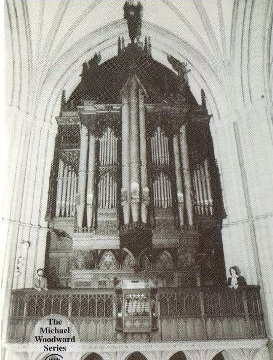 Left,
Arnold Mahon, left of the Gallery, and Lynne Davies on the
right, October, 1978.
Left,
Arnold Mahon, left of the Gallery, and Lynne Davies on the
right, October, 1978.
This recording was re-issued as a CD
in 2006 on the Priory label and is available from the Church.
Visit ‘Sales’
|
In
1978, the first solo recording of the Armley Schulze was made
for release in the Centenary year of the Organ. Playing was
shared by Lynne Davis, the American First Prize winner of the
St. Alban’s International Competition in 1975, and Arnold
Mahon. The vinyl record was produced by Michael Woodward who
enclosed it in
one
of his typically well illustrated and descriptive record
sleeves. Michael was a very talented hobbyist recording
engineer and a perfectionist for quality. His working motto,
which he said brought great personal satisfaction to all
concerned, was the opening of Shelley’s song “Rarely,
rarely comest thou; Spirit of Delight.” The “Spirit”
came from this recording which received many comlimentary
reviews in journals and magazines, showing clearly the organ’s
suitability for music of the 19th
Century
French School.
1981
an appeal was raised for funds to preserve the fabric of the
church itself, so essential as the home of the famous organ,
and as a spiritual home for the surrounding parish. Much work
had already been done on drainage and guttering to remove
sources of damp, on pointing of the tower masonry and on
repairs to the leading of the spire. A novel radiant gas
heating system had been installed to heat the church rapidly
and economically but unfortunately this did not provide the
consistent levels of temperature and humidity required for the
organ. In winter, condensation still remained a problem in the
organ loft where its elevated position produces considerable
temperature fluctuations. All available information
suggests that there are now no other Schulze organs, even in
Germany, in as completely original a state as that in St
Bartholomew's, Armley. The inability of the parish to support a
restoration, which was rapidly becoming more urgent, meant that
to secure the organ's future some outside body (national or
international, artistic or commercial) must supply the
necessary funds so that the organ could be restored and remain
in its present ideal position for another century. Meanwhile
the annual series of recitals still continued and with many
visitors it was evident that the attraction and mystique of
this unique instrument is as great as ever.
|
|
|
|
|
|
